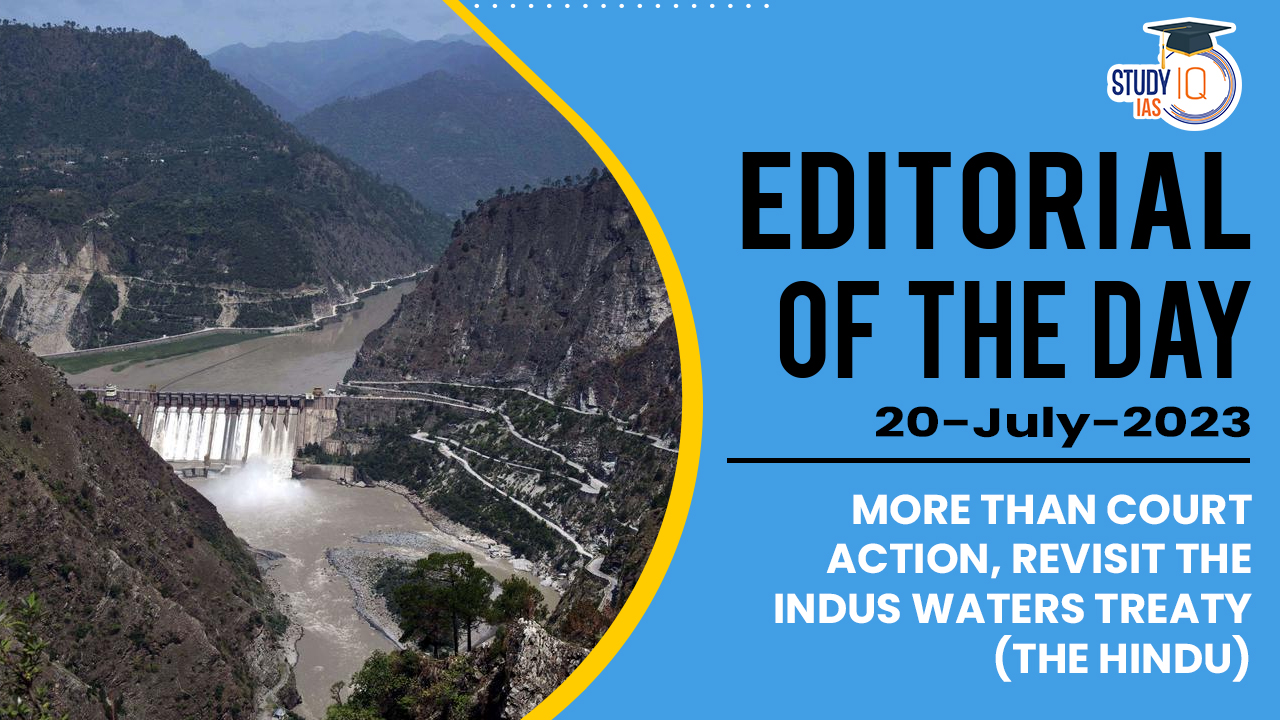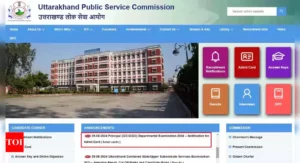Table of Contents
Context: The article is discussing the Indus Waters Treaty (IWT) of 1960, which is an agreement between India and Pakistan that regulates the use of the Indus river system and its tributaries. The treaty is considered an example of cooperation between the two neighbouring countries, despite their historically tense relations. It has survived periods of conflict and provides detailed procedures for dispute resolution. The article highlights that in recent times, there has been an increase in disputes between India and Pakistan regarding the construction and design of run-of-river hydroelectric projects on the tributaries of the Indus, Jhelum, and Chenab rivers. It argues that the two nations have differing views on the arbitration by the Permanent Court of Arbitration. The article suggests that incorporating the principles of ‘equitable and reasonable utilisation’ and the ‘no harm rule’ into the treaty could potentially help reduce tensions between India and Pakistan over water-related issues.
Background
Indus Water Treaty:
- The Indus Waters Treaty (IWT) is a water-distribution treaty between India and Pakistan to use the water available in the Indus River and its tributaries. It was mediated by World Bank.
- It was signed in Karachi in 1960 by then Indian Prime Minister Jawaharlal Nehru and Pakistani president Ayub Khan.
- Under the treaty, the control over the waters of the three eastern rivers (Beas, Ravi and Sutlej) is given to India.
- The control over the waters of the three western rivers (Indus, Chenab and Jhelum) is given to Pakistan.
The treaty allows India to use western river waters for limited irrigation use and unlimited non-consumptive use such as power generation, navigation, floating of property, fish culture, etc.

Disputes in Indus Waters Treaty:
- Pakistan has repeatedly raised objections against two hydroelectric power projects that India is constructing – one on the Kishanganga river, a tributary of Jhelum, and the other on the Chenab.
- Pakistan has asked that a Neutral Expert should be appointed to examine its technical objections to the Kishanganga and Ratle HEPs. It later proposed a Court of Arbitration.
- India requested for appointment of a Neutral Expert, arguing that Pakistan’s request for a Court of Arbitration violated the graded mechanism of dispute resolution in the Treaty.
- After the 2016 Uri Attacks, there were talks within India to walk out of the Indus Waters Treaty, which allots a significantly bigger share of the six river waters to Pakistan.
How are Disputes addressed under the treaty?
- Dispute redressal is provided under Article IX of the IWT. It’s a 3-level mechanism that makes it obligatory for India to inform Pakistan that it is planning to build a project on the Indus River system.
- Pakistan might oppose it and ask for more details. In case there is a question, that question has to be clarified between the two sides at the level of the Indus Commissioners.
- If it is not clarified, it becomes a difference that has to be handled by a Neutral Expert. It is at this stage that the World Bank enters the picture.
- In case Neutral Expert is unable to resolve the difference, then it becomes a dispute. The dispute then enters the Court of Arbitration.
Decoding the Editorial
Indus Water Treaty and Debate surrounding it:
- The Indus Waters Treaty (IWT) of 1960 is an important agreement between India and Pakistan that regulates the use of the Indus river system and its tributaries.
- Despite historical tensions between the two countries, the treaty is often seen as an example of cooperation between unfriendly neighbours.
- The IWT has endured several wars and periods of strained relations between India and Pakistan, demonstrating its resilience and ability to facilitate communication even in challenging times.
- One of the key strengths of the IWT is its provision of detailed procedures and criteria for resolving disputes related to water usage and projects.
- In recent years, there has been an increase in the use of judicial recourse to settle competing claims and objections arising from India’s construction of run-of-river hydroelectric projects on the Indus, Jhelum, and Chenab tributaries before they flow into Pakistan.
- Following this, Pakistan initiated arbitration at the Permanent Court of Arbitration in The Hague to address concerns related to the design elements of two Indian hydroelectric projects: Kishanganga (a tributary of the Jhelum) and Ratle (a project on the Chenab).
- India opposed Pakistan’s move for arbitration, believing that the Court of Arbitration was not the appropriate forum for deciding these questions and preferred the neutral expert process for resolution.
- On July 6, 2023, the Permanent Court of Arbitration made a unanimous decision, rejecting India’s objections and asserting its competence to consider and decide the disputes raised by Pakistan. The court’s decision is binding on both parties, and there is no possibility of appeal.
- The article suggests that incorporating principles such as ‘equitable and reasonable utilization‘ and the ‘no harm rule’ into the treaty could potentially help reduce tensions between India and Pakistan over water-related issues.
Future Supply of Water:
- Lack of Trust and Judicial Recourse: There is a lack of trust between the parties involved in the Indus Waters Treaty (IWT), leading them to resort to judicial recourse to settle disputes.
- The article suggests that this approach might be the only rational strategy given the current atmosphere.
- Insufficient Addressing of Growing Industrial Needs: The IWT is not likely to adequately address the rapidly growing industrial needs of both India and Pakistan, including those related to food and energy.
- Predictability and Certainty in Water Supplies: The IWT provides some element of predictability and certainty in allocating water supplies to the riparian states. However, it lacks mechanisms that allow flexibility to account for changes in the quantity of water available for allocation among the parties.
- Vulnerability to Climate Change: Bilateral water agreements, like the IWT, are vulnerable to the impacts of climate change. Many of these agreements assume that future water availability will remain the same as today, which may not hold true due to changes in precipitation patterns and runoff intensity and timing caused by climate change.
- Partitioning Logic: The IWT divides the rivers between India and Pakistan, granting proprietary rights to specific rivers for each country. However, this approach does not consider future water availability, which may be affected by climate change.
- Obligations of India and Pakistan: The IWT imposes obligations on both India and Pakistan regarding the use and flow of waters in their respective rivers. However, climate change challenges the assumptions about water supplies for agricultural and industrial purposes, making the current obligations less certain.
Principles of water course:
- Disagreement over River Partitioning: The partitioning of rivers between India and Pakistan, as outlined in the Indus Waters Treaty (IWT), is seen as problematic because it goes against the principle of treating the entire river basin as one unit.
- Thus a more holistic approach is needed to build the resource capacity of the river basin.
- Objectives of the IWT: There is a difference in interpretation between India and Pakistan regarding the objectives of the IWT.
- India views the treaty’s main objective as the optimal use of water resources, while Pakistan perceives it as ensuring the uninterrupted flow of water to its side.
- Cardinal Principles for Watercourses: To reconcile these different approaches, the article suggests the application of two cardinal principles of international watercourse law – equitable and reasonable utilization (ERU) and the principle of not causing significant harm (NHR).
- These principles are accompanied by binding obligations and are part of customary international law.
- Equitable and Reasonable Utilization (ERU): ERU, as defined in the 1997 Convention on the Law of the Non-navigational Uses of International Watercourses, involves factors like climate change and prioritizes water usage for “vital human needs.”
- Principle of No Harm (NHR): The NHR places a due diligence obligation on riparian states to prevent harm to other states when undertaking projects with potential transboundary effects on shared watercourses.
- It includes conducting transboundary environmental impact assessments.
- Conflicting Priorities: Both India and Pakistan prioritize their water uses based on their interpretations of the IWT.
- ERU is often prioritized for rapid development, possibly leading to conflicts between different water uses.
- Inclusion of Principles in the IWT: The article suggests that incorporating the principles of ERU and NHR into the IWT could help resolve differences and bring predictability to water usage.
- While these principles are already binding on both countries as customary international law, their formal inclusion in the treaty may provide greater clarity.
- World Bank’s Involvement: The World Bank, as a party to the IWT, could play a role in facilitating dialogue and cooperation between India and Pakistan by bringing together epistemic communities with common interests and knowledge about the use of Indus waters.
- Revisiting the IWT: The excerpt concludes that revisiting the IWT is a necessary step to address the challenges and complexities related to water usage and cooperation between India and Pakistan.


 UKPSC Lower PCS Recruitment 2024: Exam D...
UKPSC Lower PCS Recruitment 2024: Exam D...
 India’s First Full-Stack Quantum Compu...
India’s First Full-Stack Quantum Compu...
 World Liver Day 2025, Theme, History, Ce...
World Liver Day 2025, Theme, History, Ce...





















